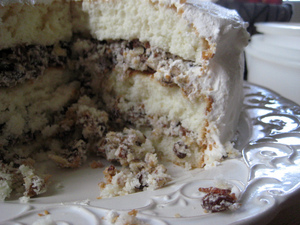Lady Baltimore Cake: A distinctive dessert for the holidays
Erin Mann is baking a new cake every week for a year from the "All Cakes Considered" cookbook and shares her adventures here on AnnArbor.com. Read past columns here.

Lady Baltimore cake with divinity frosting and a filling of figs, raisins, pecans and almonds.
Erin Mann | Contributor
-from Owen Wister’s 1906 novel Lady Baltimore
According to “All Cakes Considered,” this week’s cake was first developed in the late 1800s at a Charleston, N.C. tea room called Lady Baltimore. Owen Wister’s novel popularized the cake. To thank him, the tea room would send him one of these cakes each year at Christmas time.
The Lady Baltimore cake is a moist ‘silver’ layer cake (made with egg whites) with a fluffy white frosting and a filling made from dried fruits and nuts. The “All Cakes Considered” cookbook was my first introduction to the Lady Baltimore Cake, and let me tell you, I’m so happy to have met her.
I creamed the butter and the sugar for the cake layers, added the milk and flour mixture alternately and folded in the egg whites. The batter calls for one cup of egg whites — I used eight eggs, but depending on your eggs, it could take up to 10 to get a cup’s worth of whites. (I reserved six eggs yolks for next week’s baking adventure: Lord Baltimore cake. Egg yolks can be successfully frozen and thawed for baking by adding a little sugar to them before freezing. The sugar preserves the yolk's texture, preventing it from becoming gelatinous or lumpy.)
After I baked and cooled the cakes, I cut them into three layers. There was a thin layer of leftover cake that I tasted on its own without the flavors of the filling or frosting. The cake had a wonderful texture — it was moist and soft but not too delicate. The flavor was ever so slightly buttery and sweet.
If you own a stand mixer, making the divinity frosting is a one person job. If using a hand mixer, like me, do not attempt this alone! Another pair of eyes and hands are absolutely necessary.
I asked Rex for help. Rex boiled the sugar syrup as I beat the egg whites for the frosting. Using a candy thermometer, he kept track of the temperature of the syrup. The recipe instructs to beat in a little of the sugar syrup into the egg whites at three different temperature intervals. He poured the syrup into the bowl as I was mixing the whites. Between the second and third intervals, some of the sugar syrup was dripping down the side of the pot and started to smoke once it reached the burner. Cue the shrill repetitive beep of the smoke alarm.
The finished frosting was a shiny, white, marshmallow-y topping which looked and tasted much like a Seven-Minute Frosting that I’ve made previously. Once cooled, it’s ready to use. I mixed half frosting with the filling mixture I prepared earlier and reserved the rest of the frosting for the top and sides of the cake. The frosting became gritty; over time the sugar in the frosting re-crystallizes giving the frosting a grainy texture.
Although I tried to bake it perfectly, there were some flaws with the cake that need some attention the next time I bake a Lady Baltimore cake. The cake layers were my favorite part of this cake; the recipe for layers is definitely going in my recipe file. This silver cake would be an excellent base for any combination of fillings and frostings.
The Lady Baltimore cake filling was tasty; I like that the nuts balance the sweetness of the dried fruits. Unfortunately, the recipe yields too much filling and not enough frosting to make the filling easily spreadable. After using a liberal amount between the layers, I still had about two cups of leftover filling. I would reduce amounts of each of the fruits and nuts by ¼ cup next time.
Next week’s Lord Baltimore cake is also frosted with same divinity frosting. I will get another chance to make it and improve upon it. Do you have experience making cooked sugar syrup frostings? What are your secrets for keeping it smooth and fluffy?
I've published the recipe here.
Erin Mann is ruining diets one cake at a time with her weekly kitchen adventures. Email this baking bachelorette at SheGotTheBeat@gmail.com or follow her on Twitter. Facebook users can also keep up-to-date with A CAKE A WEEK by joining the group.


Comments
dading dont delete me bro
Tue, Dec 21, 2010 : 2:26 p.m.
i see now, sorry... https://docs.google.com/document/d/1kfc-dwVezf5YKbxfdb22opNMe6ks5audHTPp0w9KGOk/edit?hl=en&authkey=CKyVmN4I&pli=1
dading dont delete me bro
Tue, Dec 21, 2010 : 2:25 p.m.
mmmmm........ no recipe? c'mon now
Paul
Tue, Dec 21, 2010 : 12:29 p.m.
That looks great!! The figs, raisins, almonds, and what not are a great touch. I think I have had the Lord Baltimore in the past, at tea time. The Lady Baltimore will be nice to try!!
Sarah Rigg
Tue, Dec 21, 2010 : 9:14 a.m.
Just curious, Erin: What's the plan after week 52?